Annotated Bibliography: Gender in the Construction Industry
VerifiedAdded on 2022/09/28
|7
|1670
|23
Annotated Bibliography
AI Summary
This annotated bibliography examines the gender performativity of women in the construction industry, drawing on five key articles. The articles explore various aspects, including career advancement, masculinity in the building trades, gender differences in research, how women engineers navigate gender roles, and work-life balance perspectives. The bibliography highlights the challenges women face, such as gender-based discrimination, the impact of masculine work cultures, and the strategies women employ to succeed. The studies utilize diverse methodologies including literature reviews, qualitative and quantitative analyses, and critical discourse analysis, providing a comprehensive overview of the issues affecting women in this field. The articles also discuss the need for transformative movements and the importance of addressing gender inequality to create a more inclusive environment.

Student Name
INSTITUTIONAL AFFILIATION(S)
ANNOTATED BIBLIOGRAPHY
INSTITUTIONAL AFFILIATION(S)
ANNOTATED BIBLIOGRAPHY
Paraphrase This Document
Need a fresh take? Get an instant paraphrase of this document with our AI Paraphraser
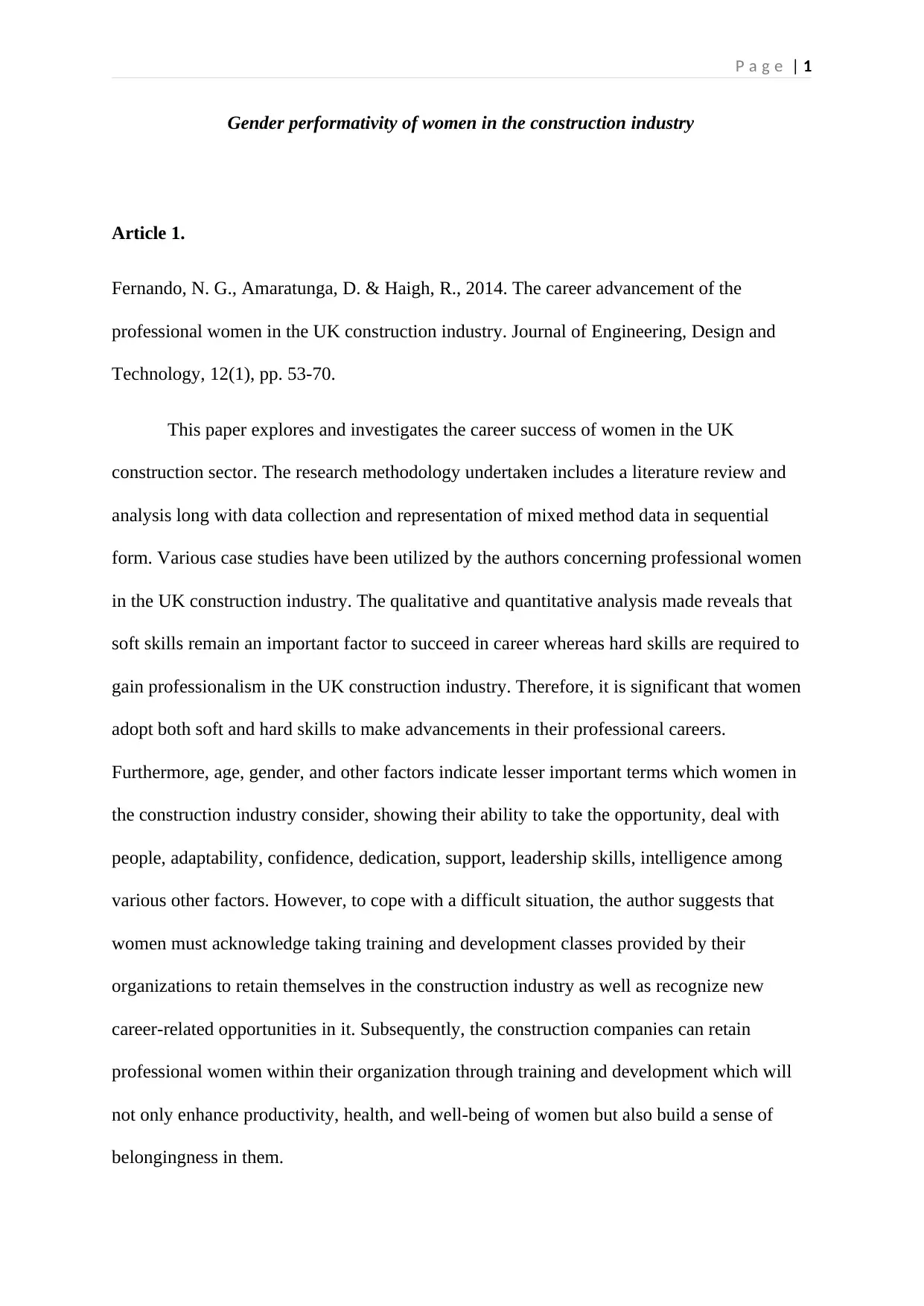
P a g e | 1
Gender performativity of women in the construction industry
Article 1.
Fernando, N. G., Amaratunga, D. & Haigh, R., 2014. The career advancement of the
professional women in the UK construction industry. Journal of Engineering, Design and
Technology, 12(1), pp. 53-70.
This paper explores and investigates the career success of women in the UK
construction sector. The research methodology undertaken includes a literature review and
analysis long with data collection and representation of mixed method data in sequential
form. Various case studies have been utilized by the authors concerning professional women
in the UK construction industry. The qualitative and quantitative analysis made reveals that
soft skills remain an important factor to succeed in career whereas hard skills are required to
gain professionalism in the UK construction industry. Therefore, it is significant that women
adopt both soft and hard skills to make advancements in their professional careers.
Furthermore, age, gender, and other factors indicate lesser important terms which women in
the construction industry consider, showing their ability to take the opportunity, deal with
people, adaptability, confidence, dedication, support, leadership skills, intelligence among
various other factors. However, to cope with a difficult situation, the author suggests that
women must acknowledge taking training and development classes provided by their
organizations to retain themselves in the construction industry as well as recognize new
career-related opportunities in it. Subsequently, the construction companies can retain
professional women within their organization through training and development which will
not only enhance productivity, health, and well-being of women but also build a sense of
belongingness in them.
Gender performativity of women in the construction industry
Article 1.
Fernando, N. G., Amaratunga, D. & Haigh, R., 2014. The career advancement of the
professional women in the UK construction industry. Journal of Engineering, Design and
Technology, 12(1), pp. 53-70.
This paper explores and investigates the career success of women in the UK
construction sector. The research methodology undertaken includes a literature review and
analysis long with data collection and representation of mixed method data in sequential
form. Various case studies have been utilized by the authors concerning professional women
in the UK construction industry. The qualitative and quantitative analysis made reveals that
soft skills remain an important factor to succeed in career whereas hard skills are required to
gain professionalism in the UK construction industry. Therefore, it is significant that women
adopt both soft and hard skills to make advancements in their professional careers.
Furthermore, age, gender, and other factors indicate lesser important terms which women in
the construction industry consider, showing their ability to take the opportunity, deal with
people, adaptability, confidence, dedication, support, leadership skills, intelligence among
various other factors. However, to cope with a difficult situation, the author suggests that
women must acknowledge taking training and development classes provided by their
organizations to retain themselves in the construction industry as well as recognize new
career-related opportunities in it. Subsequently, the construction companies can retain
professional women within their organization through training and development which will
not only enhance productivity, health, and well-being of women but also build a sense of
belongingness in them.
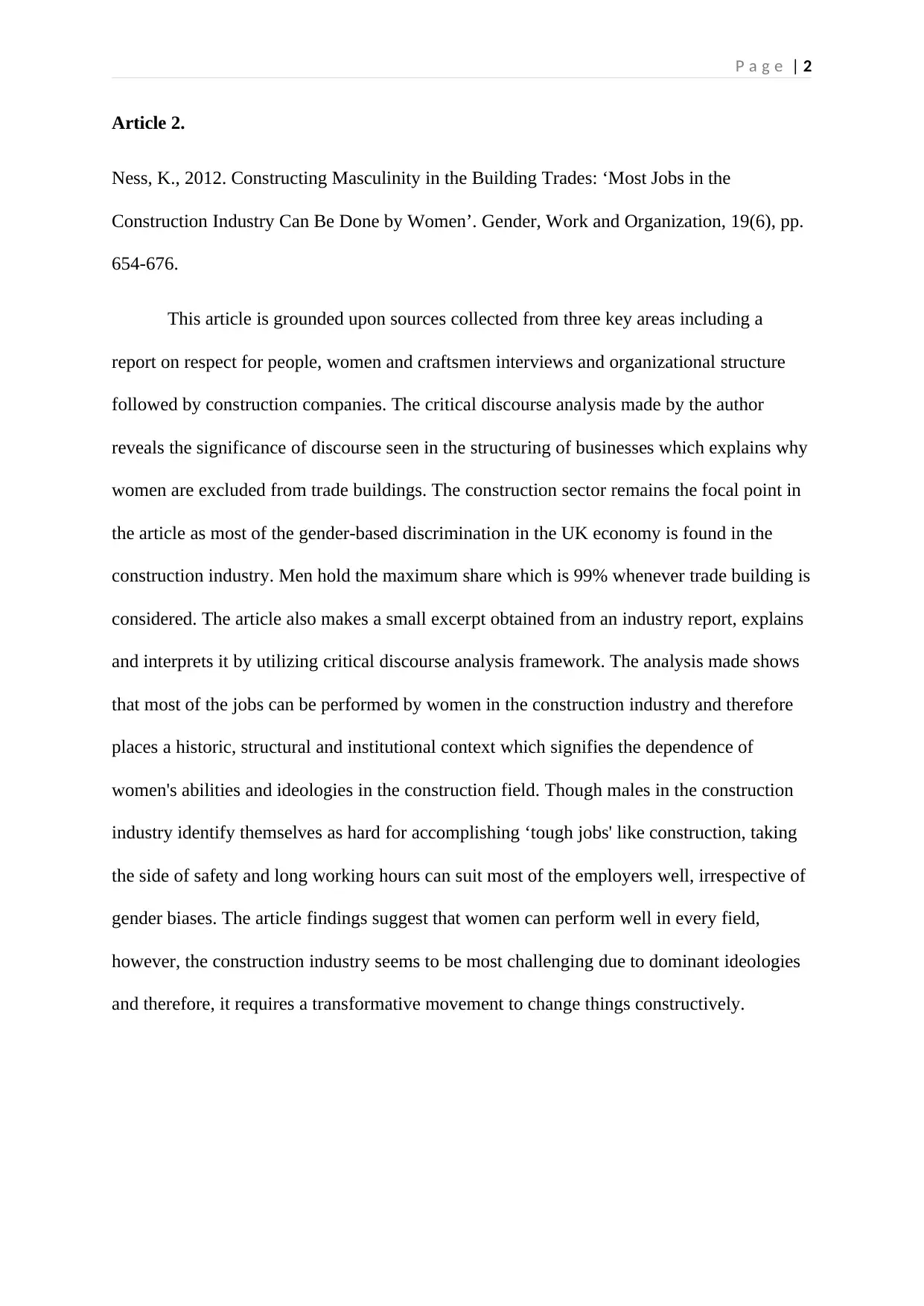
P a g e | 2
Article 2.
Ness, K., 2012. Constructing Masculinity in the Building Trades: ‘Most Jobs in the
Construction Industry Can Be Done by Women’. Gender, Work and Organization, 19(6), pp.
654-676.
This article is grounded upon sources collected from three key areas including a
report on respect for people, women and craftsmen interviews and organizational structure
followed by construction companies. The critical discourse analysis made by the author
reveals the significance of discourse seen in the structuring of businesses which explains why
women are excluded from trade buildings. The construction sector remains the focal point in
the article as most of the gender-based discrimination in the UK economy is found in the
construction industry. Men hold the maximum share which is 99% whenever trade building is
considered. The article also makes a small excerpt obtained from an industry report, explains
and interprets it by utilizing critical discourse analysis framework. The analysis made shows
that most of the jobs can be performed by women in the construction industry and therefore
places a historic, structural and institutional context which signifies the dependence of
women's abilities and ideologies in the construction field. Though males in the construction
industry identify themselves as hard for accomplishing ‘tough jobs' like construction, taking
the side of safety and long working hours can suit most of the employers well, irrespective of
gender biases. The article findings suggest that women can perform well in every field,
however, the construction industry seems to be most challenging due to dominant ideologies
and therefore, it requires a transformative movement to change things constructively.
Article 2.
Ness, K., 2012. Constructing Masculinity in the Building Trades: ‘Most Jobs in the
Construction Industry Can Be Done by Women’. Gender, Work and Organization, 19(6), pp.
654-676.
This article is grounded upon sources collected from three key areas including a
report on respect for people, women and craftsmen interviews and organizational structure
followed by construction companies. The critical discourse analysis made by the author
reveals the significance of discourse seen in the structuring of businesses which explains why
women are excluded from trade buildings. The construction sector remains the focal point in
the article as most of the gender-based discrimination in the UK economy is found in the
construction industry. Men hold the maximum share which is 99% whenever trade building is
considered. The article also makes a small excerpt obtained from an industry report, explains
and interprets it by utilizing critical discourse analysis framework. The analysis made shows
that most of the jobs can be performed by women in the construction industry and therefore
places a historic, structural and institutional context which signifies the dependence of
women's abilities and ideologies in the construction field. Though males in the construction
industry identify themselves as hard for accomplishing ‘tough jobs' like construction, taking
the side of safety and long working hours can suit most of the employers well, irrespective of
gender biases. The article findings suggest that women can perform well in every field,
however, the construction industry seems to be most challenging due to dominant ideologies
and therefore, it requires a transformative movement to change things constructively.
⊘ This is a preview!⊘
Do you want full access?
Subscribe today to unlock all pages.

Trusted by 1+ million students worldwide
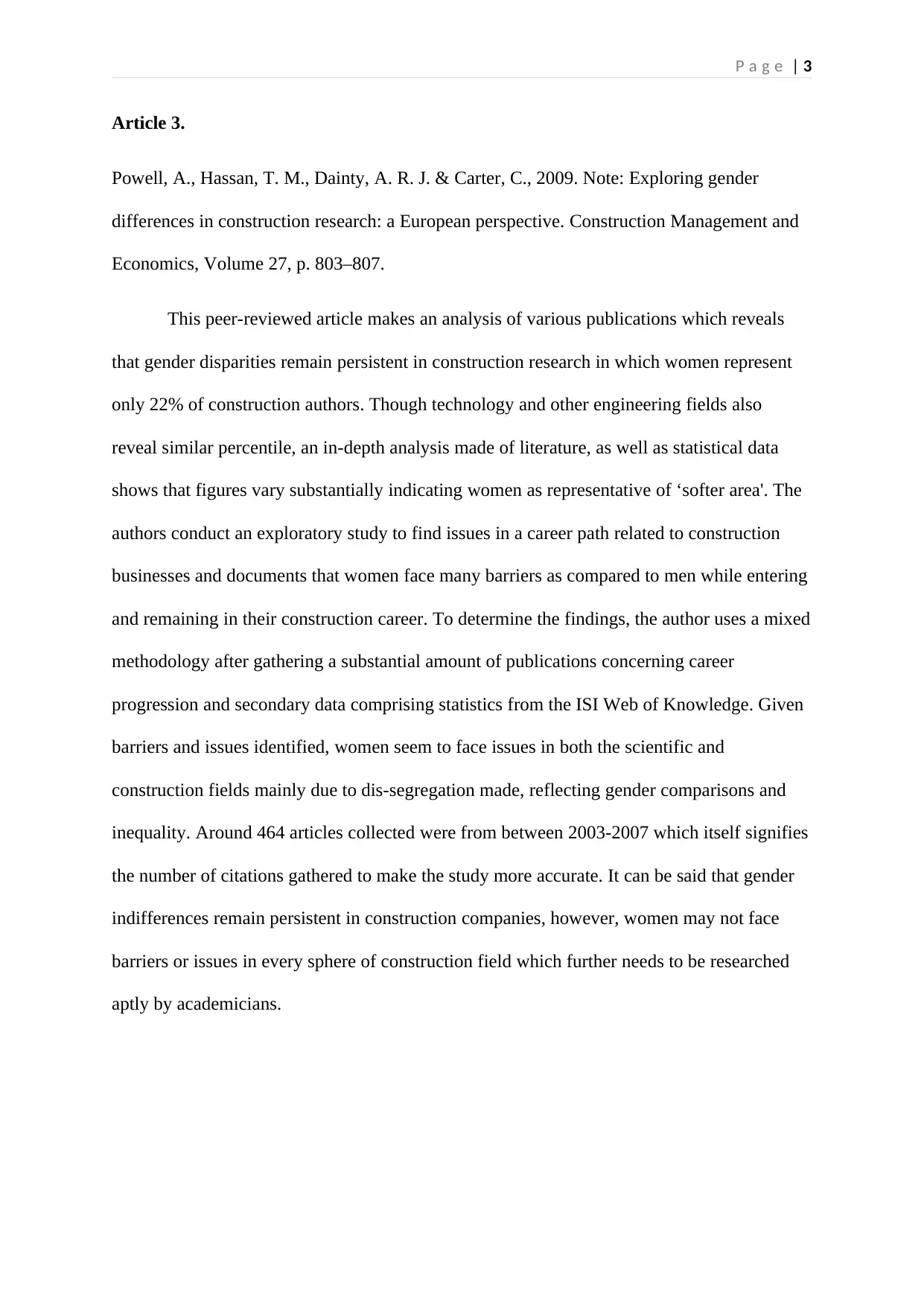
P a g e | 3
Article 3.
Powell, A., Hassan, T. M., Dainty, A. R. J. & Carter, C., 2009. Note: Exploring gender
differences in construction research: a European perspective. Construction Management and
Economics, Volume 27, p. 803–807.
This peer-reviewed article makes an analysis of various publications which reveals
that gender disparities remain persistent in construction research in which women represent
only 22% of construction authors. Though technology and other engineering fields also
reveal similar percentile, an in-depth analysis made of literature, as well as statistical data
shows that figures vary substantially indicating women as representative of ‘softer area'. The
authors conduct an exploratory study to find issues in a career path related to construction
businesses and documents that women face many barriers as compared to men while entering
and remaining in their construction career. To determine the findings, the author uses a mixed
methodology after gathering a substantial amount of publications concerning career
progression and secondary data comprising statistics from the ISI Web of Knowledge. Given
barriers and issues identified, women seem to face issues in both the scientific and
construction fields mainly due to dis-segregation made, reflecting gender comparisons and
inequality. Around 464 articles collected were from between 2003-2007 which itself signifies
the number of citations gathered to make the study more accurate. It can be said that gender
indifferences remain persistent in construction companies, however, women may not face
barriers or issues in every sphere of construction field which further needs to be researched
aptly by academicians.
Article 3.
Powell, A., Hassan, T. M., Dainty, A. R. J. & Carter, C., 2009. Note: Exploring gender
differences in construction research: a European perspective. Construction Management and
Economics, Volume 27, p. 803–807.
This peer-reviewed article makes an analysis of various publications which reveals
that gender disparities remain persistent in construction research in which women represent
only 22% of construction authors. Though technology and other engineering fields also
reveal similar percentile, an in-depth analysis made of literature, as well as statistical data
shows that figures vary substantially indicating women as representative of ‘softer area'. The
authors conduct an exploratory study to find issues in a career path related to construction
businesses and documents that women face many barriers as compared to men while entering
and remaining in their construction career. To determine the findings, the author uses a mixed
methodology after gathering a substantial amount of publications concerning career
progression and secondary data comprising statistics from the ISI Web of Knowledge. Given
barriers and issues identified, women seem to face issues in both the scientific and
construction fields mainly due to dis-segregation made, reflecting gender comparisons and
inequality. Around 464 articles collected were from between 2003-2007 which itself signifies
the number of citations gathered to make the study more accurate. It can be said that gender
indifferences remain persistent in construction companies, however, women may not face
barriers or issues in every sphere of construction field which further needs to be researched
aptly by academicians.
Paraphrase This Document
Need a fresh take? Get an instant paraphrase of this document with our AI Paraphraser
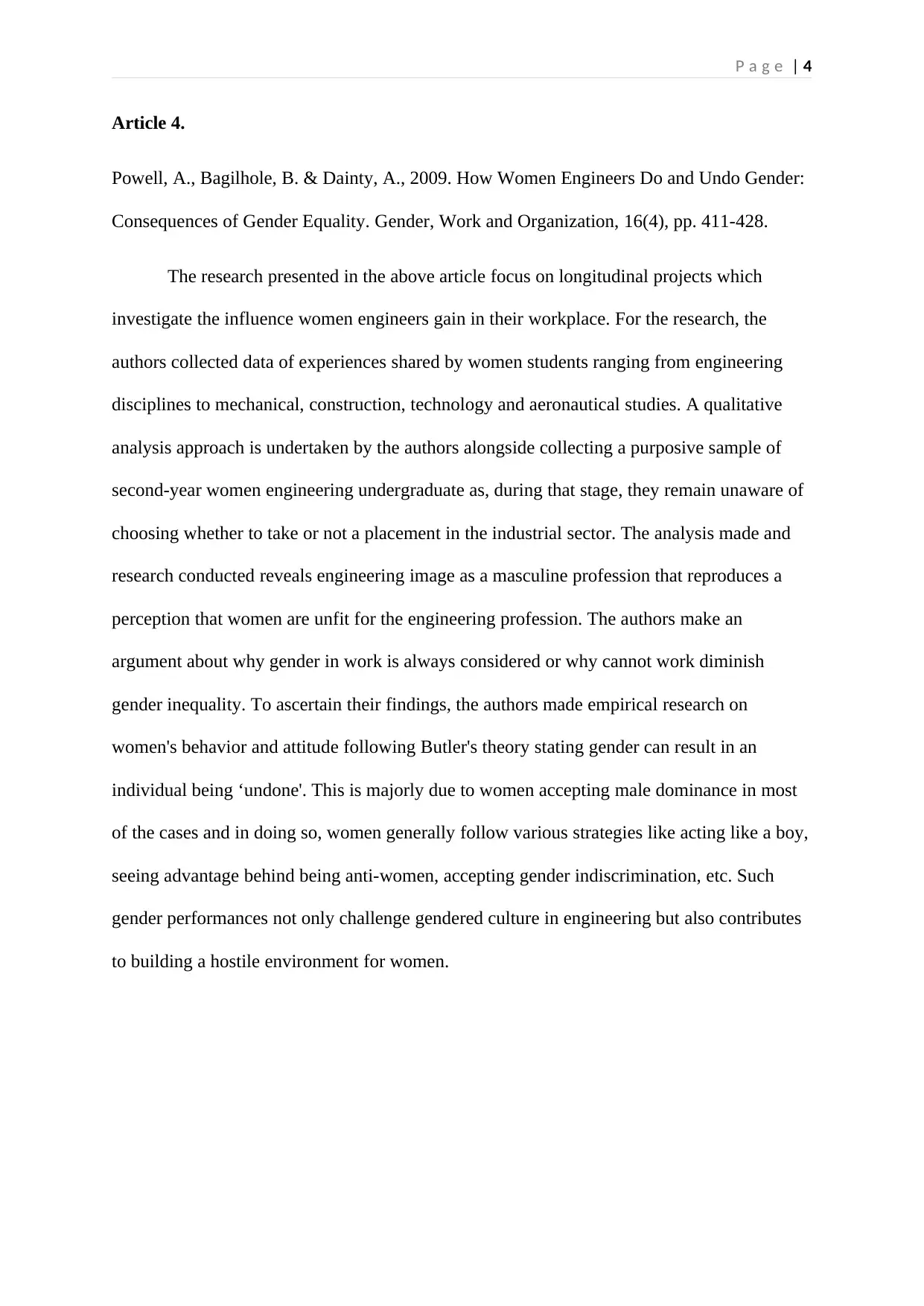
P a g e | 4
Article 4.
Powell, A., Bagilhole, B. & Dainty, A., 2009. How Women Engineers Do and Undo Gender:
Consequences of Gender Equality. Gender, Work and Organization, 16(4), pp. 411-428.
The research presented in the above article focus on longitudinal projects which
investigate the influence women engineers gain in their workplace. For the research, the
authors collected data of experiences shared by women students ranging from engineering
disciplines to mechanical, construction, technology and aeronautical studies. A qualitative
analysis approach is undertaken by the authors alongside collecting a purposive sample of
second-year women engineering undergraduate as, during that stage, they remain unaware of
choosing whether to take or not a placement in the industrial sector. The analysis made and
research conducted reveals engineering image as a masculine profession that reproduces a
perception that women are unfit for the engineering profession. The authors make an
argument about why gender in work is always considered or why cannot work diminish
gender inequality. To ascertain their findings, the authors made empirical research on
women's behavior and attitude following Butler's theory stating gender can result in an
individual being ‘undone'. This is majorly due to women accepting male dominance in most
of the cases and in doing so, women generally follow various strategies like acting like a boy,
seeing advantage behind being anti-women, accepting gender indiscrimination, etc. Such
gender performances not only challenge gendered culture in engineering but also contributes
to building a hostile environment for women.
Article 4.
Powell, A., Bagilhole, B. & Dainty, A., 2009. How Women Engineers Do and Undo Gender:
Consequences of Gender Equality. Gender, Work and Organization, 16(4), pp. 411-428.
The research presented in the above article focus on longitudinal projects which
investigate the influence women engineers gain in their workplace. For the research, the
authors collected data of experiences shared by women students ranging from engineering
disciplines to mechanical, construction, technology and aeronautical studies. A qualitative
analysis approach is undertaken by the authors alongside collecting a purposive sample of
second-year women engineering undergraduate as, during that stage, they remain unaware of
choosing whether to take or not a placement in the industrial sector. The analysis made and
research conducted reveals engineering image as a masculine profession that reproduces a
perception that women are unfit for the engineering profession. The authors make an
argument about why gender in work is always considered or why cannot work diminish
gender inequality. To ascertain their findings, the authors made empirical research on
women's behavior and attitude following Butler's theory stating gender can result in an
individual being ‘undone'. This is majorly due to women accepting male dominance in most
of the cases and in doing so, women generally follow various strategies like acting like a boy,
seeing advantage behind being anti-women, accepting gender indiscrimination, etc. Such
gender performances not only challenge gendered culture in engineering but also contributes
to building a hostile environment for women.
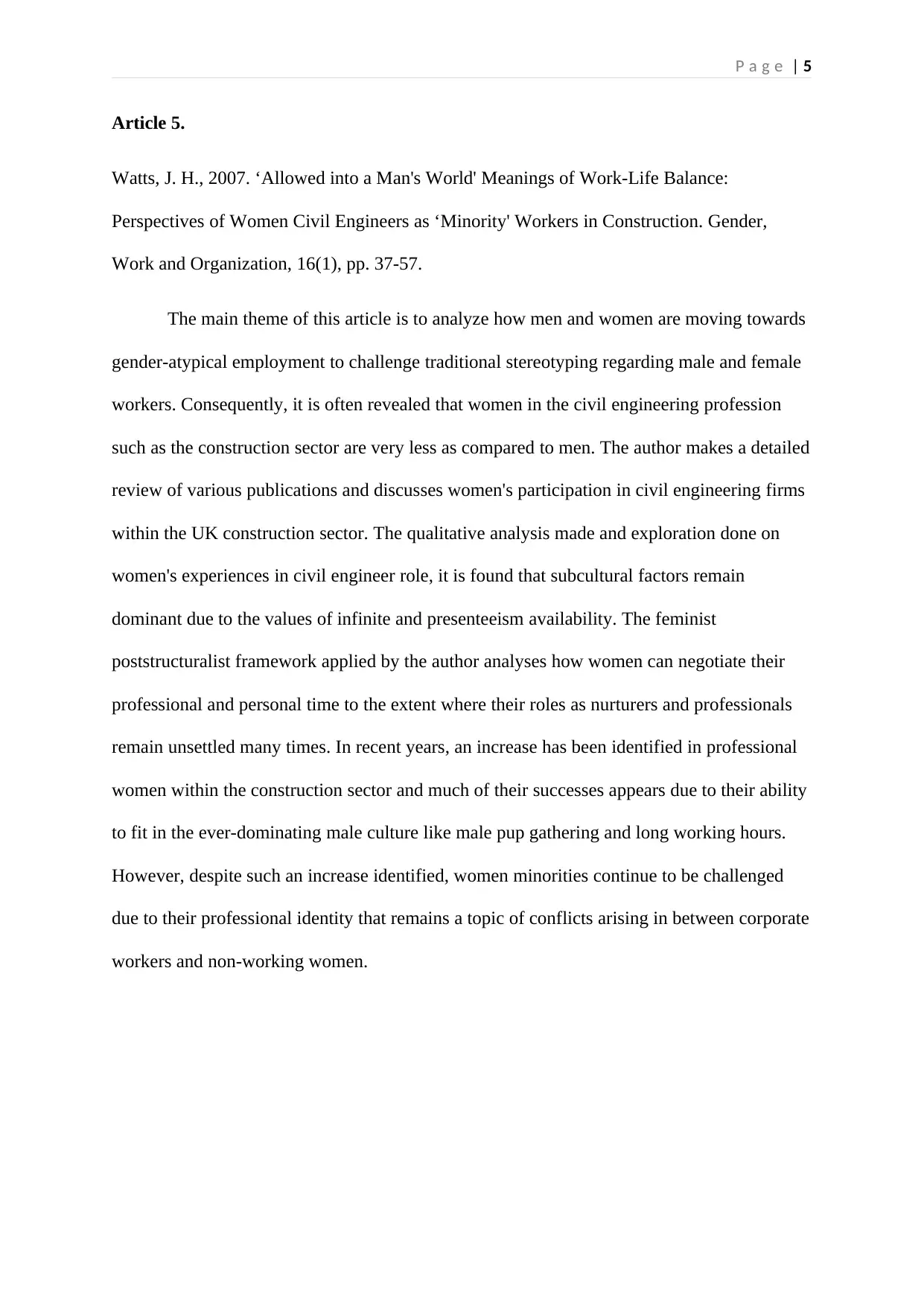
P a g e | 5
Article 5.
Watts, J. H., 2007. ‘Allowed into a Man's World' Meanings of Work-Life Balance:
Perspectives of Women Civil Engineers as ‘Minority' Workers in Construction. Gender,
Work and Organization, 16(1), pp. 37-57.
The main theme of this article is to analyze how men and women are moving towards
gender-atypical employment to challenge traditional stereotyping regarding male and female
workers. Consequently, it is often revealed that women in the civil engineering profession
such as the construction sector are very less as compared to men. The author makes a detailed
review of various publications and discusses women's participation in civil engineering firms
within the UK construction sector. The qualitative analysis made and exploration done on
women's experiences in civil engineer role, it is found that subcultural factors remain
dominant due to the values of infinite and presenteeism availability. The feminist
poststructuralist framework applied by the author analyses how women can negotiate their
professional and personal time to the extent where their roles as nurturers and professionals
remain unsettled many times. In recent years, an increase has been identified in professional
women within the construction sector and much of their successes appears due to their ability
to fit in the ever-dominating male culture like male pup gathering and long working hours.
However, despite such an increase identified, women minorities continue to be challenged
due to their professional identity that remains a topic of conflicts arising in between corporate
workers and non-working women.
Article 5.
Watts, J. H., 2007. ‘Allowed into a Man's World' Meanings of Work-Life Balance:
Perspectives of Women Civil Engineers as ‘Minority' Workers in Construction. Gender,
Work and Organization, 16(1), pp. 37-57.
The main theme of this article is to analyze how men and women are moving towards
gender-atypical employment to challenge traditional stereotyping regarding male and female
workers. Consequently, it is often revealed that women in the civil engineering profession
such as the construction sector are very less as compared to men. The author makes a detailed
review of various publications and discusses women's participation in civil engineering firms
within the UK construction sector. The qualitative analysis made and exploration done on
women's experiences in civil engineer role, it is found that subcultural factors remain
dominant due to the values of infinite and presenteeism availability. The feminist
poststructuralist framework applied by the author analyses how women can negotiate their
professional and personal time to the extent where their roles as nurturers and professionals
remain unsettled many times. In recent years, an increase has been identified in professional
women within the construction sector and much of their successes appears due to their ability
to fit in the ever-dominating male culture like male pup gathering and long working hours.
However, despite such an increase identified, women minorities continue to be challenged
due to their professional identity that remains a topic of conflicts arising in between corporate
workers and non-working women.
⊘ This is a preview!⊘
Do you want full access?
Subscribe today to unlock all pages.

Trusted by 1+ million students worldwide
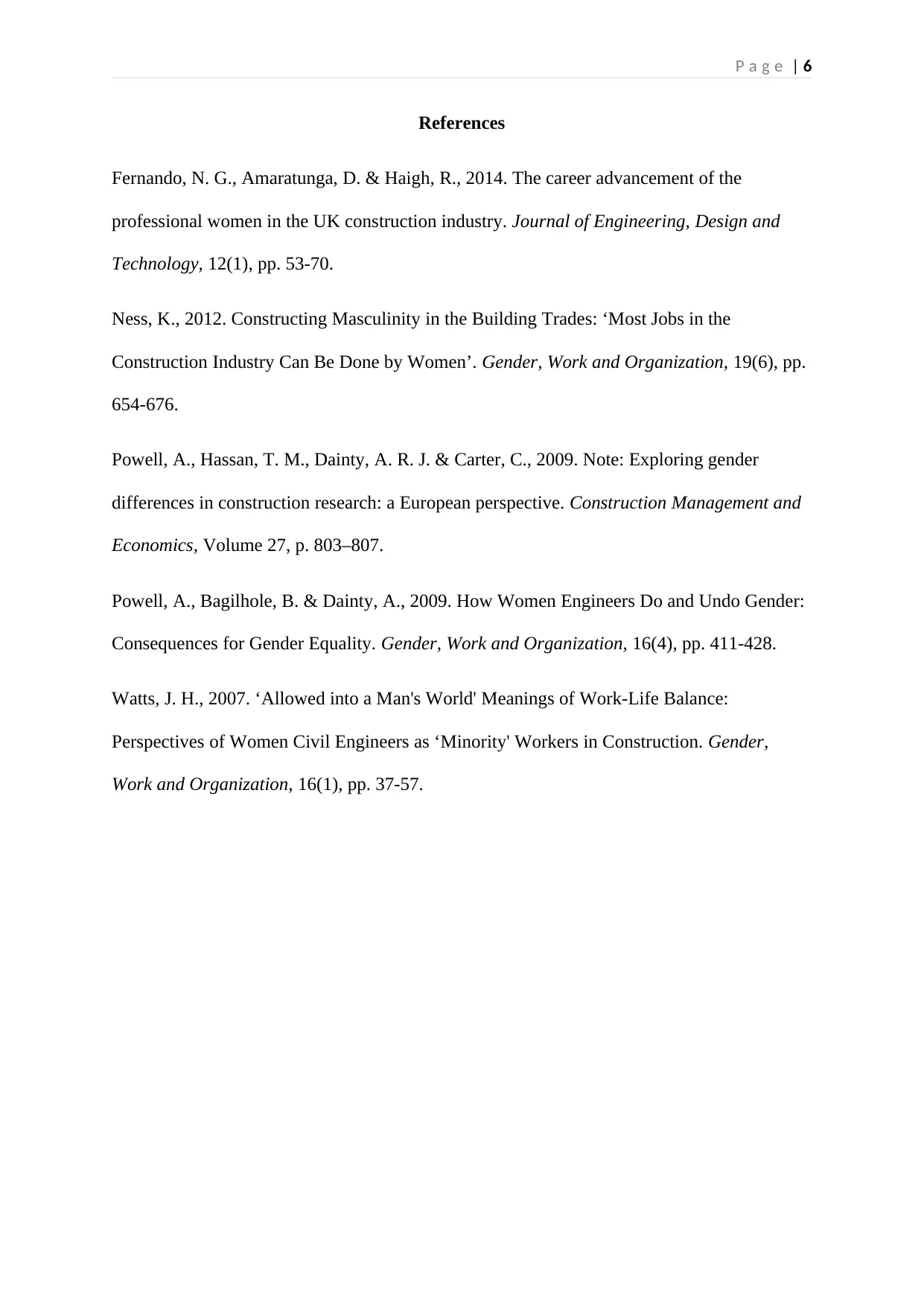
P a g e | 6
References
Fernando, N. G., Amaratunga, D. & Haigh, R., 2014. The career advancement of the
professional women in the UK construction industry. Journal of Engineering, Design and
Technology, 12(1), pp. 53-70.
Ness, K., 2012. Constructing Masculinity in the Building Trades: ‘Most Jobs in the
Construction Industry Can Be Done by Women’. Gender, Work and Organization, 19(6), pp.
654-676.
Powell, A., Hassan, T. M., Dainty, A. R. J. & Carter, C., 2009. Note: Exploring gender
differences in construction research: a European perspective. Construction Management and
Economics, Volume 27, p. 803–807.
Powell, A., Bagilhole, B. & Dainty, A., 2009. How Women Engineers Do and Undo Gender:
Consequences for Gender Equality. Gender, Work and Organization, 16(4), pp. 411-428.
Watts, J. H., 2007. ‘Allowed into a Man's World' Meanings of Work-Life Balance:
Perspectives of Women Civil Engineers as ‘Minority' Workers in Construction. Gender,
Work and Organization, 16(1), pp. 37-57.
References
Fernando, N. G., Amaratunga, D. & Haigh, R., 2014. The career advancement of the
professional women in the UK construction industry. Journal of Engineering, Design and
Technology, 12(1), pp. 53-70.
Ness, K., 2012. Constructing Masculinity in the Building Trades: ‘Most Jobs in the
Construction Industry Can Be Done by Women’. Gender, Work and Organization, 19(6), pp.
654-676.
Powell, A., Hassan, T. M., Dainty, A. R. J. & Carter, C., 2009. Note: Exploring gender
differences in construction research: a European perspective. Construction Management and
Economics, Volume 27, p. 803–807.
Powell, A., Bagilhole, B. & Dainty, A., 2009. How Women Engineers Do and Undo Gender:
Consequences for Gender Equality. Gender, Work and Organization, 16(4), pp. 411-428.
Watts, J. H., 2007. ‘Allowed into a Man's World' Meanings of Work-Life Balance:
Perspectives of Women Civil Engineers as ‘Minority' Workers in Construction. Gender,
Work and Organization, 16(1), pp. 37-57.
1 out of 7
Related Documents
Your All-in-One AI-Powered Toolkit for Academic Success.
+13062052269
info@desklib.com
Available 24*7 on WhatsApp / Email
![[object Object]](/_next/static/media/star-bottom.7253800d.svg)
Unlock your academic potential
Copyright © 2020–2025 A2Z Services. All Rights Reserved. Developed and managed by ZUCOL.




